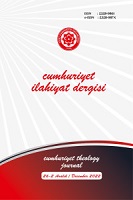Bir Şair Olarak Mustafa Esad el-Luḳaymî’nin Kudüs Gezisi
al-Quds Trip of Muṣṭafā Asʿad al-Luqaymī as a Poet
Author(s): Orhan İyişenyürekSubject(s): Cultural history, Sociology of the arts, business, education, 18th Century, Theory of Literature, Sociology of Literature
Published by: Cumhuriyet Üniversitesi İlahyat Fakültesi
Keywords: Arabic Literature; Travelogue; al-Quds; Muṣṭafā Asʿad al-Luqaymī; Mawāniḥ al-uns bi-riḥlatī li-Wādī al-Quds;
Summary/Abstract: The subject of this study is a part of the trip of Muṣṭafā Esʿad al-Luqaymī (d. 1178/1765), an Egyptian poet who lived in the 18th century. The aims of this study are to present the poems he wrote during this trip and to introduce the al-Quds section of his work Mawāniḥ al-uns bi riḥlatī li wādī al-Quds as a travelogue in terms of Arabic literature. In this work, the poet describes his sixmonth journey. This journey started from Dimyāṭ in 1143/1731, continued to al-Quds, Damascus and Lebanon respectively, and ended in Dimyāṭ again. In this study, only the poems that the poet recited during his trip to al-Quds are discussed. There are traces of strong symbolism in some of his poems. He also reflected his own spiritual experiences in his poems. Travelogues are among the genres that literature is interested in terms of their style and content. Such works contain important clues in terms of understanding how literary style develops. For many different reasons, people wanted to write down what they experienced, saw and felt during their travels and wanted to pass these notes on to others, thus the genre of travelogues emerged. The first works in the field of travelogues in Arabic literature are generally works of geographical introduction. In addition to geographical introductions, there are also examples written in the following periods, which have become a genre in which literary products, especially poems, are frequently encountered. When the phenomenon of travel is considered from the point of view of Arab literati, the first thing that catches the eye is that they generally wrote about their journeys to holy places for religious motives and for worship. It is obvious that a hadith narrated from the Prophet had a motivating effect on this issue. As mentioned in this hadith, the three mosques that are deemed appropriate to travel to are the Ka'bah, al-Masjid al-Nabī and al-Masjid al-Aqṣā. The journey that is the subject of this study is not a pilgrimage. However, as seen in the content of the work, it is seen that it is a journey in which religious feelings come to the fore in a very intense way and spiritual pleasure is prioritized. Because al-Quds was the main center where the journey took place intensely and where there were many places and authorities to visit with religious feelings. Every corner of this historical city, which is considered sacred by three major religions, is filled with the memories of prophets and religious leaders. For Muslims, the importance of al-Quds stems from the fact that it is the first Qibla and that the Prophet Muḥammad ascended the Miʿrāj from there. Although the author traveled to other places other than al-Quds, he drew attention to his journey to Jerusalem in the title of his book as if he had traveled only to al-Quds. However, al-Quds was only one of the centers he visited, but the most important one. The poet often sang poetry during his al-Quds trip, which he realized with intense religious feelings, perhaps due to the spiritual enthusiasm he experienced. The most important places he visited in al-Quds were, of course, the haram area where al-Masjid alAqṣā and the Qubbat al-Ṣakhra are located, and the historical and holy places that have a memory. Apart from these important places, he also visited the place where the Prophet's mount Al-Burāq was tied on the Miʿrāj, the stable where Solomon tied his horses, the cradle of Jesus, the city walls, the Gate of Mercy Cemetery, the Māmillā Cemetery, the Jabal al-Zaytun, Bāb al-esbāṭ (the Gate of the Tribes), ʿUbāda b. al-Ṣāmit (d. 34/654) and Shaddād b. Aws (d. 58/678), the place of Salmān al-Fārisī (d. 36/656 [?]), the Church of al-Jusmāniyya (Gethsemane, the Church of All Nations) where the tomb of the Virgin Mary is located, the tomb of Prophet Moses, the tomb of David, the Prophet Uzair , the well of Ayyūb and the spring of Sulwân. Other than visiting holy places, the poet met and exchanged information with important people living there and benefited from the spiritual experiences and guidance of some of them. Some of the people he met were Muṣṭafā al-Bakrī al-Ṣıddīqī (d. 1162/1749), the founder of the Baqriyya branch of the Khalwatiyya order, Muḥammad al-Khalīlī (d. 1147/1734), one of the Shāfiʿī jurists, Nur al-Dīn al-Jamā'ī, the chief of the preachers of the al-Masjid al-Aqṣā, Aḥmad al-Muakkīd (d. 1187/1773), ʿAli al-Daghāstānī (d. 1199/1784), Abū Bakr al-ʿAlamī, the muftī of the Ḥanafīs in al-Quds, and ʿAbd al-Muʿṭī al-Shāfiʿī (d. 1154/1741), the muftī of the Shāfiʿīs. The unearthing of the literary material in verse and prose found in the travelogues will contribute to the literature of riḥla/raḥalāt, a genre of Arabic literature, and will make the works written in this field more recognizable. Literary prose, poetry, correspondence between literary figures, treatises, and notes on the history of literature can be found in such works. This study will provide information about the poet al-Luqaymī and his life, as well as the poems he wrote about the people and places he visited during his journey in al-Quds.
Journal: Cumhuriyet İlahiyat Dergisi
- Issue Year: 26/2022
- Issue No: 2
- Page Range: 781-801
- Page Count: 21
- Language: Turkish

